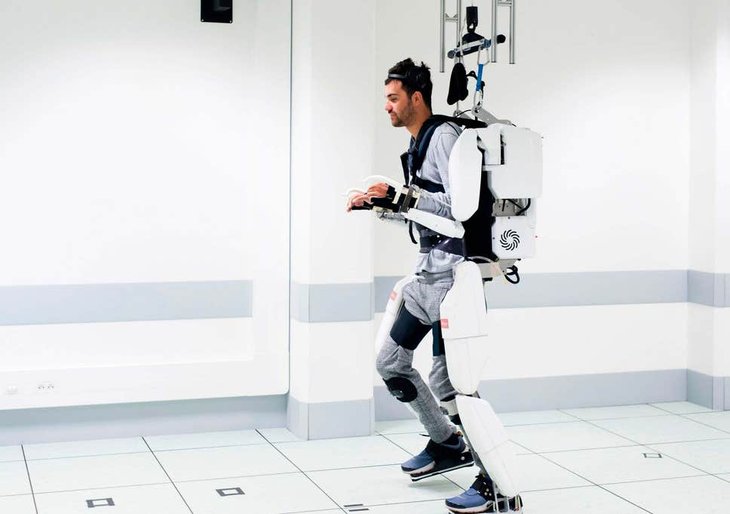This Exoskeleton Suit Helps Paralyzed Man Walk Again
Harin - Oct 07, 2019

Using his mind to control an exoskeleton, a French man who became paralysis after an incident at a night club could move his body again.
- This 7-Ton Building 'Walks' To Its New Location With 200 Robotic Legs
- This Gaming Glove Lets You Control Games With Just Hand Gestures
- This Basketball Backboard Adjusts Itself So Your Ball Cannot Miss The Hoop
For people who are recovering from paralysis, life can be tough. However, technology is on the path of finding ways to ease their struggles. Using his mind to control an exoskeleton, a French man who became paralysis after an incident at a night club could move his body again. The study could be found in Lancet Neurology Journal.
The patient whose name is Thibault went on training for months on how to instruct his brain to send signals to the exoskeleton’s computer simulator to do basic movements before he even got into the real physical exoskeleton.

Thibault living in Lyon said that with this technology, he has been given another chance. After falling 12 meters from a balcony at a night club, his spinal cord was severely damaged. As a result, he couldn’t move his body below the shoulders.
"When you are in my position, when you can't do anything with your body ... I wanted to do something with my brain," he said.
He further added that even though he couldn’t go home in his skeleton but he had been making progress since he could now walk on his own.
Alim Loius Benabid, the study’s lead author and a professor emeritus from Grenoble said that for paralyzed people, the brain can still generate commands that normally would move their arms and legs, but there’s nothing to perform the task.
To carry out this research, researchers from the Grenoble Alpes hospital, Cinatech-a biomedical company, and the CEA research center implanted two recording devices to two sides of Thibault’s head, between the skin and the brain. His sensorimotor cortex which is in charge of controlling motor function is recorded by these sensors.
Each decoder then sends brain signals. And an algorithm is responsible for deciphering them into movements that the patient wants to perform.
Thibault trained using a video game avatar and thought about executing specific tasks such as walking, or grabbing objects, etc. He succeeded in covering the distance equivalent to one and a half football fiends.
Thibault said that people like him can now have hope that walking and performing daily tasks are now possible despite their handicap.
Featured Stories

Features - Jul 01, 2025
What Are The Fastest Passenger Vehicles Ever Created?

Features - Jun 25, 2025
Japan Hydrogen Breakthrough: Scientists Crack the Clean Energy Code with...

ICT News - Jun 25, 2025
AI Intimidation Tactics: CEOs Turn Flawed Technology Into Employee Fear Machine

Review - Jun 25, 2025
Windows 11 Problems: Is Microsoft's "Best" OS Actually Getting Worse?

Features - Jun 22, 2025
Telegram Founder Pavel Durov Plans to Split $14 Billion Fortune Among 106 Children

ICT News - Jun 22, 2025
Neuralink Telepathy Chip Enables Quadriplegic Rob Greiner to Control Games with...

Features - Jun 21, 2025
This Over $100 Bottle Has Nothing But Fresh Air Inside

Features - Jun 18, 2025
Best Mobile VPN Apps for Gaming 2025: Complete Guide

Features - Jun 18, 2025
A Math Formula Tells Us How Long Everything Will Live

Features - Jun 16, 2025
Comments
Sort by Newest | Popular